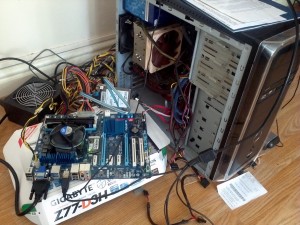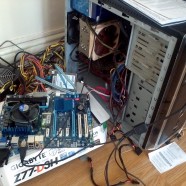Upgrading the core
The old
Computers are always changing these days and have been for the last few decades. I remember my first Windows computer, a 486 processor running at DX33 with a whopping 300Mb hard drive, which I later upgraded to a blistering 100MHz DX4. Now PCs have 2, 4 or even 8 times as many processors in a single chip and run at speeds up to 50 times higher with storage simply unthinkably large compared to the days of floppy discs. Heck even the CD / DVD has ceased to be what people save their transferable files onto due to cloud storage or USB keys which store many gigabytes of data. Something friends and I were having a laugh about over a couple of beers today in fact!
Since then I have had a couple of computers, then about 9 years ago I bought an AMD64 3200+ and fitted it on a MSI K8T Neo motherboard. It was the first computer I bought for freelancing on, custom built from components to make sure I got good value for money and could keep going for a long time. After almost a decade of service that PC is now being retired as a second power supply is finally dying, it started to sound like a small jet engine which tends to be a sure sign of impending death …
Three years ago I did build another PC to take over the the heavy lifting (Photoshop primarily for freelance, but also gaming in my downtime) which has done me well and is pretty solid – a E8400 Core 2 Duo on a P5QL Pro with 4Gb of 1066 DDR Corsair XMS2 RAM. So with the older machine on its way out I thought I would look at upgrading it a bit to give it more power, however in those 3 years computer technology has gone through another shift. The 775 socket processor line has discontinued, and as DDR3 RAM is now in I couldn’t affordably look at increasing RAM either since the P5QL is DDR2 only.
So time to start again and build a new machine! I had a limited budget though, only what I had put aside to date as my business investment budget, which meant that I would need to transfer over any useful parts from my current machines and thus would be focusing on the core of my new PC.
Motherboard and CPU
The central building block of any computer is the motherboard (onto which everything attaches to, it is the body if you will) and the CPU (quite simply put the brain). My choices were the Intel i5 3570K and Gigabyte Z77-D3H motherboard.
Chief amongst the reasons I picked these two is they are of the “Ivybridge” generation which is much more energy efficient than its predecessor the “Sandybridge”. This does mean that they are less capable when it comes to over clocking (deliberately running the processor at higher speed than it comes set at), but I don’t plan to bump the default 3.4GHz clock speed up by much. Due to budget constraint I stuck to the i5 range rather than the i7, whilst having 8 cores would have been good I just couldn’t afford it.
Gigabyte’s line of motherboards offer good versatility, this one has 6 SATA slots (or 5 and one mSATA) so there is plenty option for connectors and with a max RAM of 32Gb I knew it had plenty capacity. In top of that the board has a USB3 controller port for future proofing and importantly the integrated graphics which I planned to run my third monitor using.
Keeping it cool
 Every PC generates heat and the two elements which usually generate the most are the CPU and the graphics card. If you are keeping your costs down, not planning to run any very intensive programs like photoshop, video editing software, etc. then the stock cooler will probably do everything you need and graphics cards come with their own cooler and fan as standard.
Every PC generates heat and the two elements which usually generate the most are the CPU and the graphics card. If you are keeping your costs down, not planning to run any very intensive programs like photoshop, video editing software, etc. then the stock cooler will probably do everything you need and graphics cards come with their own cooler and fan as standard.
For my brand spanking new processor I elected to go for the Noctua NH-D14 cooler, which is frankly a beast with two heatpipe stacks and a 140mm fan between them with added 120mm for extra air flow. Why? Well I will be overclocking the processor in due course, doing a lot of photoshop work and playing a few games which will push the processor hard so I expect it to get warm form time to time.
The reason I went for a Noctua cooler rather than anything else though is because they are remarkably good at producing quiet fans. I have a pair of 120mm fans in my case to keep the airflow going from front to back and they run at a near silent level. As soon as I am watching any video or listening to music it is inaudible, and even when there is no background noise (which is rare in my flat) they are just a very quiet background hum at most.
Memory
Corsair Vengeance… Oh. No, sorry, Corsair XMS3. The one downside to using the Noctua cooler is that it is so large, it literally extends over the area that RAM is commonly installed on a motherboard, so I had to exchange my originally ordered Corsair Vengeance for Corsair XMS3. Still, 16Gb of DDR3 is very tastey indeed!
Problem, just a little one
When the first board (actually a DS3H) and CPU arrived I plugged everything in gleefully looking forward to a new machine which would run at a blistering pace and give me what I wanted. With all the wires in place I pressed the power button and blinked then stared in disbelief as the system simply did nothing. The fans had the briefest moments of power, and the LEDs blinked momentarily. Nothing came from the speaker other than the briefest pop as it got power then died.
After returning the board and CPU, then another set, I tried a different model board thinking perhaps the supplier had a bad batch. Only this didn’t work either, so I could only deduce that my FSP 700W PSU was somehow at fault. Strange really as it had been powering my s775 machine faithfully for several years now. Fortunately a friend sent me a 500W Seasonic PSU which worked straight away without issue!
What about the rest?
There’s more than these central components needed for a PC but I’ll cover that in another post shortly. To be continued …







